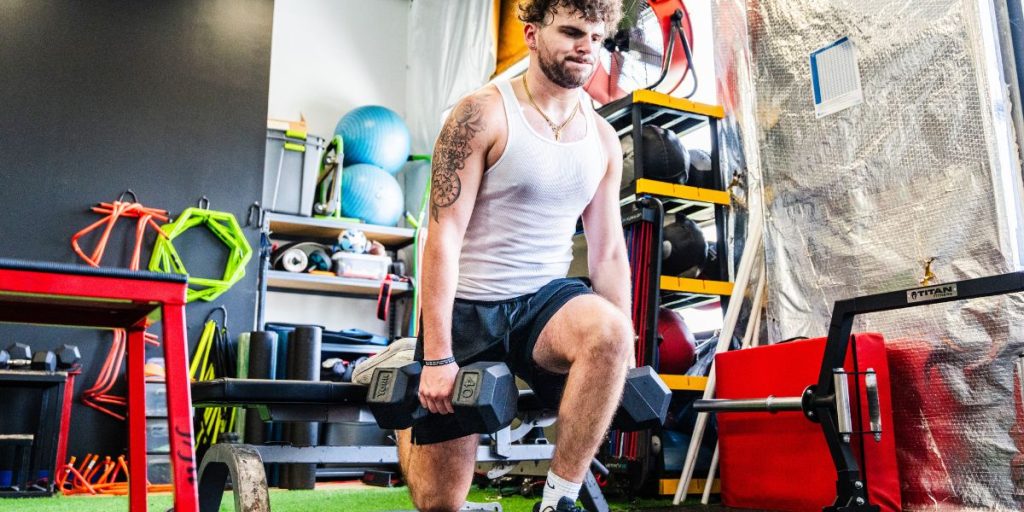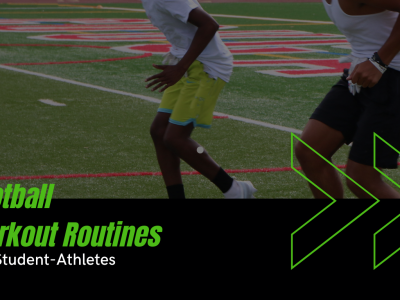Are you a student-athlete looking for football workout routines?
Whether you are looking for a training plan that improves speed and strength or routines to stay in excellent shape during the offseason, we have you covered here at Infinite Performance Training! This article outlines a comprehensive football workout routine for student-athletes, including ideas for a weekly training plan, key strength exercises, and effective cardio workouts.
You will learn how to boost performance with targeted speed drills and deliberate recovery techniques as you read. Addressing your need for training is essential, and we will also share personal training tips to guide you in this post!
Let’s dive in!
Goals of a Football Workout Routine for Student-Athletes
What should be your goals for your workout routine as a football athlete? When our football athletes train with us, we help them build strength and confidence by following a well-structured routine supporting training progress. Our workouts incorporate protein-rich nutrition coaching and focus on mastering techniques that increase explosive football players!
For most of our football athletes, they want to place a strong emphasis on the following:
- Explosive movements
- Speed and agility
- Power and strength
- Nutrition
- Recovery
The goal of your workout routine as a football student-athlete is to always ensure you hit each point above, including recovery and nutrition! For most athletes, the issue with their routine is not training; it is overtraining and not recovering!
Here is how to create the optimal workout routine for football players!
Structure Your Weekly Training Plan to Maximize Performance

The first step is to balance strength training with conditioning, assign specific days for skill improvement, and schedule dedicated rest and recovery sessions. You minimize the risk of injury and optimize your strength when you plan. As you work with a personal trainer, you can have custom plans that help keep you injury-free and focused for optimum performance.
1. Balance Strength Training and Conditioning
Achieving the proper balance between strength training and conditioning to support joint stability and cultivate discipline has an art and science aspect. We rely on tailored programs that reinforce your training for your specific football position (quarterback vs defensive line, for example) with a central focus on the following:
| Component | Focus |
|---|---|
| Strength Training | Joint stability, discipline, core fortification |
| Conditioning | Endurance, thorax development, enhanced agility |
| Programs | Tailored exercises for optimal performance |
2. Designate Days for Skill Improvement
We recommend all football players allocate specific days to enhance their skills, integrating gym workouts 3-4 times a week. Tailored workout routines for football players and sessions to boost cardiovascular fitness ensure you build strength and precision on the field. This focused training method addresses your challenges and sets a clear path toward improved performance and confidence on the field come the regular season!
3. Include Rest and Recovery Sessions
Recovery is considered to be more important than working out in some instances! Incorporating specific rest and recovery sessions will reduce the risk of overtraining; these periods allow you to sharpen footwork, improve ball control, strengthen your running techniques, and even integrate drills for overall coordination.
Remember, recovery doesn’t mean you can’t work, you can do the following on recovery/rest days:
- Focus on low-impact activities during recovery sessions
- Schedule regular breaks to prevent overtraining
- Utilize recovery techniques to refine footwork and ball handling
- Incorporate cross-training activities such as tennis for additional agility
- Foam rolling
- Sauna or cold plunges
- Hot Yoga
✅ 10 Optimal Recovery Techniques Article
Focus on Essential Strength Training Exercises for Football Athletes
You focus on essential strength training exercises for football athletes, targeting upper body drills to boost your strength training and explosive performance. Your plan also integrates lower body workouts, improves core stability, and uses interval training to boost your metabolism, which is perfect for playing tight end. Detailed guidance on each aspect follows next.
Target Upper Body Exercises for Enhanced Performance
You boost your upper body performance by using a barbell to develop strength while incorporating a medicine ball to improve coordination and snap through each movement; exercises like the squat not only build muscle but also lessen stress on your joints as you prepare for challenging drills:
- Barbell presses that sharpen your power
- Medicine ball movements for improved coordination
- Hanging variations to build core stability
- Explosive movements like cleans or snatches (proper form required)
- Unilateral vs bilateral movements
- Controlled exercises to minimize stress while maintaining snap speed
When you work with a trainer at Infinite Performance Training like CJ, we help you refine these techniques with each session, ensuring you are ready for the intensity of football training.
Integrate Lower Body Strength Workouts
Integrating lower body strength workouts that effectively reduce fatigue and prevent injury ensures you perform best during your practices and games! Lower body explosives and what we call “Body armor” help prevent injuries during the season.
| Workout Component | Benefit |
|---|---|
| Squats | Prevents injury by building robust leg muscles |
| Single Leg Lunges | Reduces fatigue and enhances sprint performance, functional movements |
| Deadlifts | Improves overall lower body strength for college-level training |
| Functional Movements | Box jumps, burpee box jumps, sled push, wall balls |
Employ Core Stability Routines
You boost your performance by incorporating core stability routines that refine your control during workouts at school and sharpen your movement for flag football drills. These exercises, inspired by gymnastics techniques, provide the nutrient boost and force needed to enhance your stability and overall strength:
| Exercise | Benefit |
|---|---|
| Planks | Improves overall core strength and force generation |
| Russian Twists | Enhances rotational power and control, valuable for all football players |
| Leg Raises | Boosts nutrient distribution and stabilizes the core |
Speed and Agility Drills Football Routine

You strengthen your game with sprints and acceleration workouts, agility ladder drills, and cone drills for rapid direction changes. You balance overhead press and dumbbell routines to support your back while managing training frequency and recovery. These exercises offer practical insights to boost your speed and agility during football practice.
Implement Sprints and Acceleration Workouts
Incorporate sprints and acceleration workouts to sharpen your performance and speed on the football field, simulating the quick start of a lineman or wideout during play. Refine these workouts by integrating exercises that involve a weight plate to boost your strength. Ensure you stay hydrated with water breaks and cool down with ice treatments as needed. This regimen provides actionable insights that directly address your need for improved quickness and reliable recovery during practice sessions.
Agility Ladder Drills for Quick Feet
We train agility by using the ladder to build acceleration and quick footwork that directly benefits a defensive back’s performance on the field, as you use drills to improve your mass control and enhance cycling between movements:
- Step drills to develop precision
- Lateral shuffles for improved side-to-side speed
- Multi-directional runs to boost overall agility
- Interval exercises that incorporate acceleration bursts
Practice Cone Drills for Direction Change
You work with targeted cone drills to sharpen your agility, making quick changes in direction that mimic the explosive movements you perform during football matches. You incorporate drills that require you to shift your weight rapidly and engage your arm strength, complementing the benefits of exercises like deadlift and lunge to build overall stability and control. This focused practice helps you directly translate improved coordination and quick directional responses onto the field.
Develop Cardiovascular Endurance For Football Players
You set your sights on building endurance through steady-state running, interval training for maximum efficiency, and circuit-based conditioning. These drills, integrated with smart nutrition tips and Infinite Performance Training, form a solid foundation for football workout routines to boost torso strength and blitz performance in every practice session.
Engage in Steady-State Running
You enhance your endurance training with steady-state running, which not only boosts cardiovascular capacity but also supports your efforts in powerlifting, core stability, and bodybuilding, all while sharpening your brain’s focus and coordination during physical performance:
- Run at a consistent pace to build stamina, including sprint intervals
- Integrate steady-state sessions into your weekly regimen
- Monitor your performance to adjust the intensity as needed
Utilize Interval Training for Maximum Efficiency
Football is a quick-paced sport, and you can increase your efficiency by incorporating interval training. Interval training keeps your body in constant motion to improve blood circulation and overall stamina.
Interval training consists of max-effort bursts with a timer that simulates a game and conditions the body for in-season training. Unlike swimmers who train for long races, football players need to train for about 100 plays per game, lasting around 4-10 seconds per play.
Incorporate Circuit-Based Conditioning
For football players, you boost your cardiovascular endurance by incorporating circuit-based conditioning, which mirrors the precise mechanics needed for a wide receiver’s explosive moves and mirrors the energy you bring to each session; this method ties elements of Olympic weightlifting and ensures proper form at the elbow to minimize injury risks during intense drills:
| Circuit Step | Description |
|---|---|
| Power Lift | Integrates olympic weightlifting moves to develop energy and core mechanics |
| Agility Drill | Mimics wide receiver routes, emphasizing quick, controlled movements |
| Flexibility Focus | Targets the elbow and joint areas to maintain optimal performance |
Emphasize Recovery & Nutrition for Optimal Results
You boost recovery and nutrition with a clear focus on hydration, tailored diet plans, and stretching routines to sharpen your toe movements. Below are the three key areas to focus on:
1. Hydration
Proper hydration fuels muscle recovery and boosts flexibility, allowing you to maintain a strong leg and overall power during your workouts and your season. Maintaining your hydration levels ensures your body efficiently absorbs the nutrient-rich fuel from foods like fish and supports your fitness plan for football players, letting you perform at your best. When you stay well-hydrated, you experience enhanced recovery, reduce the risk of injury, and pave the way for professional-level progress.
2. Nutrition Plans Tailored for Student-Athletes
Protein translates to “of first order,” essentially meaning it is the primary ingredient you need to recover. Typically, football athletes should intake at least 1 gram of protein per desirable body weight, with the true goal of 1.5 grams. Thus, if a football player wants to weigh 200 pounds, they should eat 200-300 grams of protein a day (which is a substantial amount).
Select nutrition plans designed to reduce excess fat and support your circulatory system, incorporating whole foods like quality carbs to fuel optimal recovery after training sessions. Pull together balanced meals that include lean proteins and fresh produce, and your recovery shake foams lightly, providing the right mix of nutrients to maintain energy and boost performance on the field.
✅ We have a partnership with Meal Dealers of the DMV for all of our athletes, and you can receive 20% off at checkout with our discount code!
3. Stretching and Mobility Work for Recovery
Be sure to incorporate stretching and mobility exercises into your recovery routine to prevent injuries during running sessions and support your overall football strength training program performance.
Here are some quick ideas to include in your football workout routine each week:
| Activity | Benefit |
|---|---|
| Dynamic Stretching | Prepares muscles for running and high-intensity drills |
| Static Stretching | Aids in muscle recovery after intense football strength training sessions |
| Mobility Work | Boosts flexibility, enhancing performance for all football players |
The Verdict on Football Workouts Near Me:

If you are looking for football workouts “Near Me” and you are in the Gainiesville, VA, area, then let’s see how Infinite Performance Training can help you! We have expertise in training student-athletes who play football from elementary school through the college and professional ranks.
CJ Jones has been training football players in NOVA for over twenty years and has carved out a reputation as one of the best at designing student-athlete football workouts for both off-season and in-season programs!
We have helped athletes at the following high schools perform at the highest level for football:
- Gainesville High School Football
- Patriot High School Football
- Battlefield High School Football
- Brenstsville District High School Football
- Osborne High School Football
- Unity Reed High School Football, and many more!
GET IN TOUCH
Schedule a Training Session
Frequently Asked Questions
1. How can you structure your weekly training plan for football?
Plan your week by allocating specific days for strength training, tactical drills, speed work, and recovery. Alternate intense sessions with skill-focused days, set clear goals and monitor progress to build balanced performance. We typically encourage 3-4 strength and explosion days, 1-2 skill and speed days, and 1-2 recovery days during the offseason.
2. What strength exercises benefit football student-athletes most?
Football student-athletes benefit from resistance training and plyometric drills that build power and speed. Exercises like squats, deadlifts, and bench presses help develop strength crucial for long-lasting on-field performance, and unilateral movements and stability drills help prevent injury.
3. How should you incorporate speed drills into your routine?
Integrate speed drills by adding short, focused intervals post-warm-up to boost agility and refine technique. Consistency in your practice assists athletic progress and improves performance during each training session, so adding shuttle runs, single-leg movements, and explosion drills will help with speed.
4. What cardio workouts suit football players best?
Football players perform best with bursts of speed and recovery, such as interval training or circuit routines that mimic game conditions, boosting endurance and power on the field. Running miles, for example, is not the ideal form of conditioning for football players; instead, short 5-10-second bursts repeated are ideal.
5. Why is recovery crucial for achieving optimal results?
Recovery, which induces sleep and rest days, is key to achieving maximal performance! Remember, optimal recovery sharpens your training by letting muscles repair and reducing injury risk, ensuring long-lasting performance improvements for student-athletes engaging in personal training routines.


 Infinite Performance Training: Athlete Success Stories
Infinite Performance Training: Athlete Success Stories
Leave a Reply